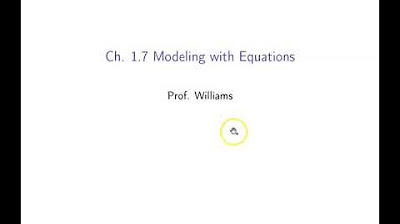Math 7 6 4 Homework Help Morgan
TLDRThis video script explores the application of tape diagrams and equations in solving word problems involving unknown quantities. It demonstrates mental math strategies for simple equations and guides viewers through drawing tape diagrams for more complex situations. The script covers various scenarios, including marker packs, ribbon cutting, brick bundles, skate rentals, and brownie distribution, illustrating how to represent and solve problems with equations. It also includes exercises for students to practice these concepts, emphasizing the importance of equations in reasoning about relationships between quantities.
Takeaways
- 😀 The lesson focuses on using tape diagrams to reason about equations and solve for unknown amounts in various situations.
- 🔍 Mental math and logic are emphasized for solving equations without writing them down, such as recognizing that 4 + 1 = 5 or 2 × 5 = 10.
- 📚 Section one involves algebraic talk, encouraging students to find solutions to equations like x + 1 = 5 and 2x + 1 = 10 through reasoning.
- 📈 Section two introduces situations and diagrams, where students draw tape diagrams to represent situations and decide what to represent with a variable.
- 🖋️ Diego's marker situation involves seven packs of markers with x markers each, and after receiving nine more, the total is 30 markers, represented by 7x + 9 = 30.
- ✂️ Elena's ribbon cutting involves a 30-foot ribbon, cutting off seven feet, and dividing the rest into nine equal lengths of x feet, leading to the equation 7 + 9x = 30.
- 🏗️ The construction manager's brick bundle weighs 30 pounds, consisting of nine identical bricks and a seven-pound block, represented by 9x + 7 = 30.
- 🛼 The skating rink charges a group rate of nine dollars plus a fee for each pair of skates, with seven pairs rented totaling thirty dollars, leading to 9 + 7x = 30.
- 🍰 Andre bakes nine pans of brownies, donates seven, and divides the rest among 30 students, resulting in the equation 7 + 30x = 9.
- 📉 The lesson concludes with matching situations to equations and solving them, demonstrating how equations can be used to express relationships between quantities and reason about unknowns.
Q & A
What is the main topic of the video script?
-The main topic of the video script is reasoning about equations and tape diagrams, particularly how they can be used to solve problems involving unknown amounts in various situations.
What is the purpose of using mental math in the script's initial examples?
-The purpose of using mental math in the initial examples is to demonstrate how to quickly find solutions to simple equations without the need for writing them down, thus building an intuitive understanding of algebraic concepts.
How does the script introduce the concept of tape diagrams in problem-solving?
-The script introduces tape diagrams as a visual tool to represent situations and equations, helping to break down complex problems into simpler parts and find relationships between different quantities.
What is the significance of the variable 'x' in the tape diagrams?
-In the tape diagrams, 'x' represents an unknown quantity that needs to be determined. It helps to express the relationship between known and unknown amounts in a given situation.
Can you explain the process of solving the equation 7x + 9 = 30 as described in the script?
-The process involves subtracting 9 from both sides of the equation to isolate the term with 'x', resulting in 7x = 21. Then, dividing both sides by 7 gives the solution x = 3.
What is the equation that represents Diego's markers situation in the script?
-The equation representing Diego's markers situation is 7x + 9 = 30, where 'x' stands for the number of markers in each pack after Lynn gives him nine more markers.
How does the script use tape diagrams to solve the problem of Elena cutting a 30-foot piece of ribbon?
-The script creates a tape diagram with nine sections of 'x' feet each, representing the nine equal lengths of ribbon, and one section of seven feet, which Elena cuts off initially. The total length is 30 feet, leading to the equation 7 + 9x = 30.
What is the equation that matches the story of the construction manager weighing bricks and a concrete block?
-The equation that matches the story is 9x + 7 = 30, where 'x' represents the weight of each of the nine identical bricks.
How does the script approach the problem of Andre baking brownies for students?
-The script sets up an equation 7 + 30x = 9, where 'x' represents the fraction of each of the two remaining pans of brownies that is divided among the 30 students.
What is the key takeaway from the video script regarding equations and their role in reasoning about unknown quantities?
-The key takeaway is that equations can represent relationships between quantities in various situations, and by writing and solving equations, we can reason about and determine the values of unknown quantities.
Outlines
📚 Math Unit 6 Lesson 4: Reasoning with Equations and Tape Diagrams
This paragraph introduces a math lesson focusing on reasoning about equations and tape diagrams. It discusses how to mentally solve simple equations without writing anything down, using examples such as 'x + 1 = 5' to demonstrate the process of finding the unknown value. The lesson then moves on to more complex situations where tape diagrams are used to represent variables and solve for unknown amounts in various scenarios, such as the number of markers in packs given to Diego or the length of ribbon segments cut by Elena.
📏 Applying Tape Diagrams to Real-World Situations
The second paragraph delves deeper into using tape diagrams to represent real-world situations, such as the distribution of markers, cutting a ribbon into equal lengths, weighing bricks, renting skates, and baking brownies. Each situation is translated into a mathematical equation that includes a variable, which is then solved to find the unknown quantity. The paragraph emphasizes the importance of understanding the relationship between quantities in a situation and how equations can be used to reason about unknown values.
🔢 Solving Equations to Understand Situations
This paragraph continues the theme of solving equations derived from various situations. It matches each situation with its corresponding equation and then solves for the variable. The solutions provide insights into the problems, such as the weight of individual bricks, the rental fee for skates, and the division of brownies among students. The paragraph concludes with a summary of the importance of equations in expressing relationships between quantities and reasoning about unknowns.
📐 Estimating Geometric Properties: Perimeter and Diagonal of a Square
The fourth paragraph shifts focus to geometric properties, specifically the perimeter and diagonal of a square. It involves estimating these properties based on the side length of the square. The speaker provides a method to estimate the perimeter and diagonal length, then compares these estimates to the actual measurements, highlighting the importance of accurate geometric understanding and estimation skills.
🤔 Multiplication Problems and Story Equations
In this paragraph, the script presents a series of multiplication problems and three stories, each with an associated equation. The problems involve positive and negative numbers, and the stories include scenarios about buying show tickets, sharing juice, and working at an art fair. The paragraph explains how to match each story with the correct equation and determine what the variable x represents in each context.
🎨 Solving for Variables in Story Equations and Plotting Points
The final paragraph concludes the lesson by solving the equations from the stories and explaining the reasoning behind the solutions. It also includes a task to plot points on a coordinate plane and calculate the vertical distance between two points. The speaker demonstrates the process of solving for x in each equation, providing the cost of tickets, the amount of juice per friend, and the time spent painting frames. The paragraph ends with a summary of the activities and a reminder to check with the teacher for any specific requirements.
Mindmap
Keywords
💡Algebra
💡Equations
💡Tape Diagrams
💡Variables
💡Mental Math
💡Situations and Diagrams
💡Multiplication
💡Perimeter
💡Diagonal
💡Story Problems
💡Solving Equations
Highlights
Introduction to using tape diagrams for reasoning about equations and solving unknown amounts in stories.
Mental math strategy to solve equations like x + 1 = 5 by recognizing that 4 + 1 equals 5.
Applying the same mental math to find the value of x in equations involving multiplication.
Drawing tape diagrams to represent situations with variables and unknown amounts.
Creating a tape diagram for Diego's markers situation with seven packs and additional markers given.
Developing an equation 7x + 9 = 30 from the tape diagram to represent the total markers.
Using tape diagrams for a ribbon cutting scenario to represent the total length and sections cut.
Formulating an equation 30 - 7 + 9x = 30 to represent the remaining length of the ribbon.
Exploring a construction manager's problem with bricks and a concrete block weighing a total of 30 pounds.
Representing the weight of identical bricks and a concrete block with the equation 9x + 7 = 30.
Solving for the rental fee of skates using the equation 9 + 7x = 30 to find the cost.
Analyzing Andre's brownie baking scenario with nine pans and donating seven to a bake sale.
Creating an equation 7 + 30x = 9 to represent the division of remaining brownies among students.
Matching situations to equations and finding solutions to determine the values of x.
Solving the brick problem to find each brick weighs two and five-ninths pounds.
Determining the rental fee for skates is three dollars using the equation solution.
Calculating the portion of brownies each student receives as 1/15 of the two pans left.
Summary of using equations to express relationships between quantities in a situation.
Homework guidance on drawing a square, predicting perimeter, and estimating the length of the diagonal.
Multiplication practice with positive and negative numbers, and decimal points.
Story problems involving tickets to a show, juice distribution, and art fair work hours.
Equation matching to stories and solving for the value of x in each scenario.
Solving for ticket price, juice per friend, and time spent painting frames.
Using a diagram and corresponding equation to find the solution and explain reasoning.
Plotting points on a graph and calculating vertical distances between points.
Transcripts
5.0 / 5 (0 votes)
Thanks for rating:





